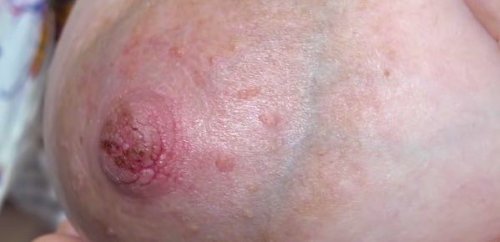Preventing and Curing Sore, Cracked Nipples

Painful, cracked nipples are a very common problem for breastfeeding mothers. This problem can have many causes, but there are also ways of treating and preventing it.
In this article, we’ll tell you everything you need to know about curing sore, cracked nipples.
Beginning to breastfeed is undoubtedly one of the moments that shapes the unique bond between mother and child. Not everything about this time is rosy, however.
Many difficulties may take some (although not all) of the magic away from this stage in both of your lives.
One of the most common problems is cracked nipples and pain during or after breastfeeding. This can happen for many reasons.
Causes of sore, cracked nipples
- An infection in the nipples or milk ducts. If you feel strong shooting pains and your baby has to make a noticeable effort to nurse, speak to your doctor. They’ll generally take a sample to identify the source of the infection and find the right solution.
- Temporary physiological pain. Your milk will come in gradually over the first few days. This means that your baby may need to press down harder at first in order to feed. As the days go by, breastfeeding should become less painful.
- Incorrect breastfeeding posture. If your baby isn’t in a position that allows them to latch on properly, that is, with their mouth over your nipple and part of the areola, pressure in the wrong places may lead to cracked skin. This can be very painful.
- Taking your baby off your breast too quickly. Lightly press the corner of their lips with a finger, let air in, and then take your baby away slowly.
- Dysfunctional nursing. If your child has a tongue tie or short lingual frenulum, the sucking mechanism may not be very efficient. This can cause pain in breastfeeding mothers.
It’s important to clarify that breastfeeding itself shouldn’t be painful. Any discomfort the mother feels while breastfeeding is a sign that she should check that everything is ok, or seek help from a professional.
How to avoid sore, cracked nipples
The most important thing in these cases is to check that your baby is nursing correctly. If your baby is in the right position and latches on properly, breastfeeding shouldn’t be painful at all.
There are professionals who specialize in helping new moms with these problems. Don’t hesitate to contact them.

In order to regulate the amount of milk in your breasts at any one time, it’s best to breastfeed frequently.
This way, you’ll produce the right amount of milk from the very beginning, and avoid full, sore breasts. You can also use a breast pump.
If there is a problem with your breastfeeding position, look for advice on how to help your baby nurse more efficiently.
Breastfeeding advocacy charities can have useful tips on how to avoid these problems, including an asymmetrical grip and reclining position to help your baby latch on painlessly.
Finally, if your problems with sore, cracked nipples are due to a tongue tie, look for a position that will compensate for your baby’s difficulties nursing.
Can sore, cracked nipples be prevented?
Since sore, cracked nipples are caused by breastfeeding problems, skin creams or balms aren’t of much use for preventing them before they happen. These products can be helpful, however, to treat cracks after they occur.
However, we can’t repeat it enough: it’s important to address underlying problems to help make breastfeeding comfortable for you and your baby. Doing this from the start is the best form of prevention, and is better than a cure.

Another technique that has been proven to be effective is to spray a little olive oil on the nipple and areola, and to let the area breathe.
In the past, a common recommendation was to rub a little breast milk on the affected area. If there is a bacterial infection, however, this will just worsen the problem.
Wash your breasts gently with water, avoiding soap, which can remove the natural protection from the skin in this area.
As a final tip, it’s worth remembering above all that breastfeeding is fundamental in the first few months of your baby’s life. Try at all costs not to give up breastfeeding.
If you suffer from any of the problems we’ve mentioned here, be patient and seek expert help, and they’ll go away in a few days.
Painful, cracked nipples are a very common problem for breastfeeding mothers. This problem can have many causes, but there are also ways of treating and preventing it.
In this article, we’ll tell you everything you need to know about curing sore, cracked nipples.
Beginning to breastfeed is undoubtedly one of the moments that shapes the unique bond between mother and child. Not everything about this time is rosy, however.
Many difficulties may take some (although not all) of the magic away from this stage in both of your lives.
One of the most common problems is cracked nipples and pain during or after breastfeeding. This can happen for many reasons.
Causes of sore, cracked nipples
- An infection in the nipples or milk ducts. If you feel strong shooting pains and your baby has to make a noticeable effort to nurse, speak to your doctor. They’ll generally take a sample to identify the source of the infection and find the right solution.
- Temporary physiological pain. Your milk will come in gradually over the first few days. This means that your baby may need to press down harder at first in order to feed. As the days go by, breastfeeding should become less painful.
- Incorrect breastfeeding posture. If your baby isn’t in a position that allows them to latch on properly, that is, with their mouth over your nipple and part of the areola, pressure in the wrong places may lead to cracked skin. This can be very painful.
- Taking your baby off your breast too quickly. Lightly press the corner of their lips with a finger, let air in, and then take your baby away slowly.
- Dysfunctional nursing. If your child has a tongue tie or short lingual frenulum, the sucking mechanism may not be very efficient. This can cause pain in breastfeeding mothers.
It’s important to clarify that breastfeeding itself shouldn’t be painful. Any discomfort the mother feels while breastfeeding is a sign that she should check that everything is ok, or seek help from a professional.
How to avoid sore, cracked nipples
The most important thing in these cases is to check that your baby is nursing correctly. If your baby is in the right position and latches on properly, breastfeeding shouldn’t be painful at all.
There are professionals who specialize in helping new moms with these problems. Don’t hesitate to contact them.

In order to regulate the amount of milk in your breasts at any one time, it’s best to breastfeed frequently.
This way, you’ll produce the right amount of milk from the very beginning, and avoid full, sore breasts. You can also use a breast pump.
If there is a problem with your breastfeeding position, look for advice on how to help your baby nurse more efficiently.
Breastfeeding advocacy charities can have useful tips on how to avoid these problems, including an asymmetrical grip and reclining position to help your baby latch on painlessly.
Finally, if your problems with sore, cracked nipples are due to a tongue tie, look for a position that will compensate for your baby’s difficulties nursing.
Can sore, cracked nipples be prevented?
Since sore, cracked nipples are caused by breastfeeding problems, skin creams or balms aren’t of much use for preventing them before they happen. These products can be helpful, however, to treat cracks after they occur.
However, we can’t repeat it enough: it’s important to address underlying problems to help make breastfeeding comfortable for you and your baby. Doing this from the start is the best form of prevention, and is better than a cure.

Another technique that has been proven to be effective is to spray a little olive oil on the nipple and areola, and to let the area breathe.
In the past, a common recommendation was to rub a little breast milk on the affected area. If there is a bacterial infection, however, this will just worsen the problem.
Wash your breasts gently with water, avoiding soap, which can remove the natural protection from the skin in this area.
As a final tip, it’s worth remembering above all that breastfeeding is fundamental in the first few months of your baby’s life. Try at all costs not to give up breastfeeding.
If you suffer from any of the problems we’ve mentioned here, be patient and seek expert help, and they’ll go away in a few days.
This text is provided for informational purposes only and does not replace consultation with a professional. If in doubt, consult your specialist.








